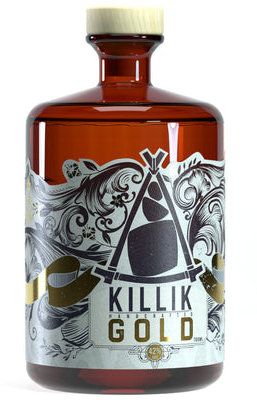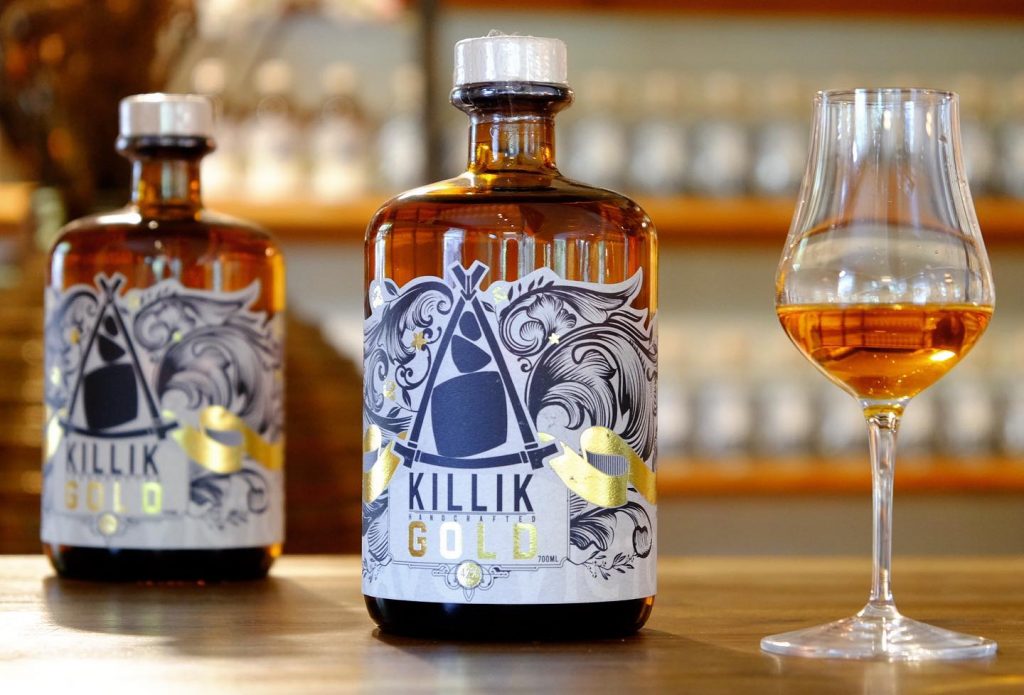Note: Although the bottle label does not refer to the product as “rum” – which suggests that under Australian law it cannot be so called because it is aged less than two years – I am referring to it as such given the fact that under rules elsewhere in the world (and my own common sense) all of its production criteria make it one.
Killik Handcrafted Rum is a small distillery in southern Australia that shares several similarities with its neighbour in Melbourne, JimmyRum, and, in fact, with several others that will form part of this small series of Australian rums. For one, it is of recent vintage, having been envisioned, established and brought to operation in 2019 by a family team (Ben and Callan Pratt); makes gin and cocktails to help cover costs until the rum stuff gets a head of steam; and has an attached cafe to the distillery which gets the urban customers rolling in for a bite to eat to go with the tasting menu. The distillery compound in a picturesque section of eastern Melbourne just by Sherbrooke Forest makes for a good location to entice day-trippers and tourists who stop by for a snack and a cocktail.
What distinguishes the small distillery from others — who also have a good location, also established an on-site restaurant-cum-cafe and also had to come up with imaginative approaches to survive doing lockdowns — is its stated focus on recreating a high-ester, hogo-laden series of rums. This they do (according to their website) primarily by using “a wild fermentation process” that I can only assume is by utilisation of a non commercial yeast strain or wild yeast itself. Whether they actually follow what high-ester Jamaican rum makers do – use muck to supercharge ester fermentation – cannot be gleaned from that website, which is actually not very helpful about much and doesn’t even mention what kind of still they use or whether they start off with molasses or cane juice.
However, Mr. and Mrs. Rum’s daily instagram notes in December 2021 fill in the pieces: the company uses molasses, and yes, they do add in dunder at various stages of the ferment; the still is a 1000-liter hybrid with option for four plates, six plates, or pot distillation; and they source barrels from a local cooperage. All that leads us into the three rums they make: the silver, the silver overproof and the one we’re looking at today, the “Gold” which was aged in Chardonnay casks (for less than two years, hence the qualifier about calling it a “rum”) and is noted as being a high ester rum with a strength of 42% ABV but with no reference to whether it is from pot or column still, or a blend. Honestly, I wish this kind of thing was better explained and laid out for the genuinely curious (and these days, that’s most of us).
 Clearly the Gold is made for a market that is timorous in its tastes, because 42% is not, I suggest, enough to showcase serious hogo action (though it does dampen it down enough so that the uninitiated would not to leave the premises traumatised, tearful and trembling). The first aromas are a testament to that: paint, plasticine, rubber overlaid with the forest green scent of damp rotting logs covered with moss and Fisherman’s Friend cherry bonbons. That may not sound like something you’d want to bring home to Mommy, but it really is not too shabby, and in any case, be of good cheer, for there’s more and better coming. As the initial sharply fruity and offbeat aromas dissipate, they are replaced by vanilla, sweet Danish cookies, caramel, toffee, nougat, nuts and honey – not too strong, quite straightforward here, and good enough for Government work.
Clearly the Gold is made for a market that is timorous in its tastes, because 42% is not, I suggest, enough to showcase serious hogo action (though it does dampen it down enough so that the uninitiated would not to leave the premises traumatised, tearful and trembling). The first aromas are a testament to that: paint, plasticine, rubber overlaid with the forest green scent of damp rotting logs covered with moss and Fisherman’s Friend cherry bonbons. That may not sound like something you’d want to bring home to Mommy, but it really is not too shabby, and in any case, be of good cheer, for there’s more and better coming. As the initial sharply fruity and offbeat aromas dissipate, they are replaced by vanilla, sweet Danish cookies, caramel, toffee, nougat, nuts and honey – not too strong, quite straightforward here, and good enough for Government work.
The palate stays with this easygoing motif and lets the aggro of the initial nose go its own way (which I submit is our loss); there’s some initial brine and olives, a faint lingering memory of rubber, and then a small bowl of fruit is opened up: pears, melons, papaya, a touch of strawberries and tart mangos, and a pimento infused bitter chocolate or two for kick. There’s some caramel and sweet dark grapes coiling around behind it all, and the whole experience wraps up in a short, breathy finish with just the memory of some fruits, a bit of tart but creamy yoghurt, and that’s all she wrote.
So, how to rate it? Now, I ran it through my glass blind and didn’t know anything about it before beginning, so I went in with no preconceived notions and came to the conclusion I did based purely on the tasting and a knowledge of the strength; and the score it was given reflected a better-than-average sort of quality, because all this high-ester hogo business was not on my radar and I discovered it for myself. Would I have rated it higher had I known it was daring to be a Jamaican, or lower for not being one? Maybe, but that’s why I taste and score first and research later wherever possible, and not the other way ‘round.
Short version, the rum feels like an entry-level product, with the esters evident, dissipating fast, and not making enough of a statement. While the rum’s tastes – especially the first ones – are interesting, they lack force, complexity, integration. And yet for all that, the Killik Gold is not a fall-down fail. It’s merely a rum that starts well, is minimally aged, and in the early stages of being something else, something in the producers’ minds which has yet to snap more clearly and more distinctively into focus. In five years Killik will probably have something really fascinating for us to try: here though, we’re being given an early essay in the craft, a rum that suggests rather more exciting potential than it currently manages to deliver.
(#887)(78/100) ⭐⭐⭐
Other Notes
- As with all the Australian rums reviewed as part of the 2021 Aussie Advent Calendar, a very special shout out and a finger-tap to the fedora to Mr. And Mrs. Rum, who sent me a complete set free of charge. Thanks again to you both.
- The website entry for this rum notes it as being aged 12 months in Chardonnay casks, nothing else.
- At first I thought the logo represented an aboriginal motif similar to the Canadian First Nations’ Inukshuk (a marker made from carefully placed stones), but Killik’s “About” page showed that the name and the logo they chose was no accident and actually related to shipping: “The name “Killik” is derived from the word “killick”, being an old anchor handcrafted by encasing stone in a wooden frame. To us, Killik represents strength and stability, while taking a nod to the classic archetype of bottles of rum making their way around the Caribbean on old rustic ships.” After reading around some more, I found out that a killick was also a slang term for a sailor first class (or “leading seaman” – the term has been retired) in the Royal Canadian Navy. The discontinued old style insignia for this rank used to be a ‘fouled’ anchor – an anchor with a length of rope twisted around it). Both term and insignia continue to be used in other navies, including the British, from whence it probably originated.
